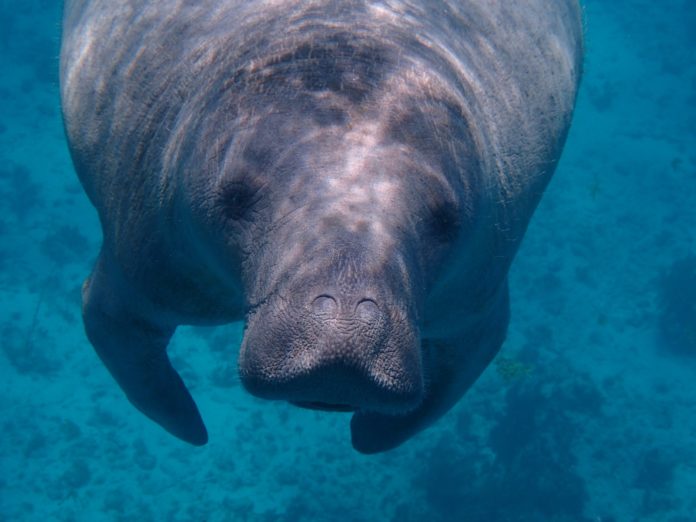
Christopher Columbus sailed the ocean blue in 1492. Even if he was not the first to “discover” the New World, his four trips across the Atlantic did rack up several “firsts” that can be peripherally connected to the Florida Keys.
For example, he is thought to have introduced citrus aurantifolia, what came to be called the Key lime, to the New World. He also “discovered” the pineapple and introduced its sweet flavor to European palettes.
There is another apparent first attributed to him. On Jan. 9, 1493, Christopher Columbus wrote about mermaids in his logbook. “On the previous day,” he wrote, “the Admiral went to the Rio Del Oro, he said he quite distinctly saw three mermaids, which rose well out of the sea; but they are not so beautiful.” Depending on the account, Columbus wrote something like “they have a face like a man”, “their faces had some masculine traits” or some version of the mermaids not being as pretty as they appeared in paintings.
Of course, the Italian explorer was not writing about mermaids but the West Indian manatee. What Columbus wrote is now considered the earliest recorded account of a manatee in the New World. When his son Ferdinand accompanied Columbus on his fourth New World adventure, he wrote in his journal that the sirens “not be fishes but real calves… inside they have nothing like a fish.” He also noted that the creatures “fed on grass and that their meat both resembled and tasted like veal.”
It was not the last time sailors mistook the manatee for the mythical mermaid. However, it is difficult to imagine the level of “horniness” or “drunkness” necessary to mistake the robust marine mammal for a mermaid. What the two have in common is that they are, in a manner of speaking, both sirens. In some languages, in Greek, the word for mermaid is siren. The scientific name for classifying manatees and dugongs harkens back to their connection to the mermaid’s legend. They belong to the order Sirenia.
While often referred to as sea cows, they are distant cousins of the elephant. Unlike the more ethereal mermaid, manatees (and dugongs) have been historically hunted for their meat and hides. It was certainly the case for Florida’s aboriginal people and the territory’s early settlers.
Efforts to protect Florida’s manatees date back to the 18th century. According to British colonial records, in 1764: “His majesty… (proposed) that an Instruction should be given to the Governor of the Provence of East Florida to restrain him from granting any person whatsoever, without his Majesty’s particular Orders and directions, those parts of the Coast of the said Province frequented by the Animals called the Manati or Sea Cow, where they have their Echouries (estuaries) or Landing Places.”
The proposal was ignored by the Indians and the settlers, who continued to hunt manatees for food. When John James Audubon visited the Florida Keys in 1832, he hired James Egan as his guide. In addition to providing guide services, Egan built a two-and-a-half-story building on Indian Key that he operated as a boarding house. It was here, at Egan’s boarding house, where Audubon stayed during his Indian Key visit. About Egan, Audubon wrote: “For years his employment had been to hunt those singular animals called Sea Cows or Manatees, and he had conquered hundreds of them, ‘merely;’ as he said, because the flesh and hide bring ‘a fair price’ at Havannah.”
Egan was not alone in his endeavors, and the animals would continue to be legally hunted the same as alligators, turtles and conch for decades. In 1885, the following observation was recorded about the state of the manatee in Florida: “Ten years ago the meat could be bought at fifty cents a pound. The animals are becoming far too scarce to admit to its being sold at all. There is no doubt that the manatee is fast becoming an extinct animal. … The sea cow will pass out of existence … and the only remaining trace of its former existence will be a few old bones.”
Florida’s first official attempt at protecting the manatee came with the passing of Florida state law Chapter 4208.94 in 1893. In 1907, the state passed Chapter 370.12 to strengthen their legal protection by making the killing or molesting of them punishable by a $500 fine and/or six months of jail time. It would take decades, and further declines in manatee populations, before government agencies took their official pen to ink additional efforts to protect not just manatees but other struggling species.
In 1966, the Federal Endangered Preservation Act was created and followed, in 1969, by the Federal Endangered Species Conservation Act. Additional protection was given to manatees and all marine mammals in 1972 with the passing of the Federal Marine Mammal Protection Act, which made it a crime to disturb, disrupt, molest, ride, harm or kill a marine mammal – at least in U.S. waters.
Still, these gentle giants need protecting. When they are not starving to death due to seagrass die-offs, about half of all reported manatee deaths come from careless boaters not paying attention to their surroundings and not respecting no-wake zones. If we are not careful, the manatee may indeed go the way of the West Indian monk seal, and “the only remaining trace of its former existence will be a few old bones.”
























